Related Research Articles
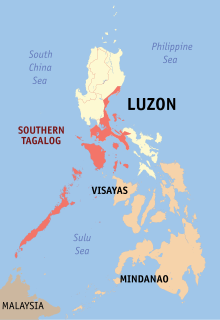
Southern Tagalog, designated as Region IV, was an administrative region in the Philippines that comprised the current regions of Calabarzon and Mimaropa, the province of Aurora of Central Luzon, and several cities of Metro Manila. The name remains as a geographical region only, which exempts Aurora.

The Bisayan languages or Visayan languages are a subgroup of the Austronesian languages spoken in the Philippines. They are most closely related to Tagalog and the Bikol languages, all of which are part of the Central Philippine languages. Most Bisayan languages are spoken in the whole Visayas section of the country, but they are also spoken in the southern part of the Bicol Region, islands south of Luzon, such as those that make up Romblon, most of the areas of Mindanao and the province of Sulu located southwest of Mindanao. Some residents of Metro Manila also speak one of the Bisayan languages.
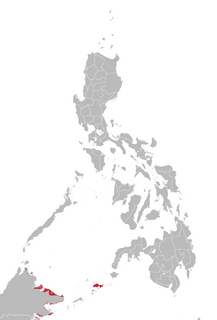
Tausug is an Austronesian language spoken in the province of Sulu in the Philippines and in the eastern area of the state of Sabah, Malaysia, by the Tausūg people. It is widely spoken in the Sulu Archipelago, the Zamboanga Peninsula, southern Palawan, and Malaysia.
The Central Philippine languages are the most geographically widespread demonstrated group of languages in the Philippines, being spoken in southern Luzon, Visayas, Mindanao, and Sulu. They are also the most populous, including Tagalog, Bikol, and the major Visayan languages Cebuano, Hiligaynon, Waray, Kinaray-a, and Tausug, with some forty languages all together.
Ratagnon is one of the eight indigenous groups of Mangyan in the southernmost tip of Occidental Mindoro and the Mindoro Islands along the Sulu Sea. The Ratagnon live in the southernmost part of the municipality of Magsaysay in Occidental Mindoro. Their language is similar to the Visayan Cuyunon language, spoken by the inhabitants of Cuyo Island in Northern Palawan.

Mangyan is the generic name for the eight indigenous groups found on the island of Mindoro, southwest of the island of Luzon, the Philippines, each with its own tribal name, language, and customs. The total population may be around 280,000, but official statistics are difficult to determine under the conditions of remote areas, reclusive tribal groups and some having little if any outside world contact.
Cuyonon is a regional Bisayan language spoken on the coast of Palawan and the Cuyo Islands in the Philippines. Cuyonon had been the lingua franca of the province of Palawan until recently when migration flow into the region rapidly increased. 43% of the total population of Palawan during the late 1980s spoke and used Cuyonon as a language. Later studies showed a significant decrease in the number of speakers due to an increase of Tagalog-speaking immigrants from Luzon.
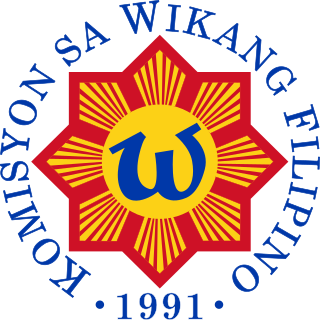
The Commission on the Filipino Language (CFL), also referred to as the Komisyon sa Wikang Filipino (KWF), is the official regulating body of the Filipino language and the official government institution tasked with developing, preserving, and promoting the various local Philippine languages. The commission was established in accordance with the 1987 Constitution of the Philippines.

The Philippine languages or Philippinic are a proposed group by R. David Paul Zorc (1986) and Robert Blust that include all the languages of the Philippines and northern Sulawesi, Indonesia—except Sama–Bajaw and a few languages of Palawan—and form a subfamily of Austronesian languages. Although the Philippines is near the center of Austronesian expansion from Formosa, there is little linguistic diversity among the approximately 150 Philippine languages, suggesting that earlier diversity has been erased by the spread of the ancestor of the modern Philippine languages.
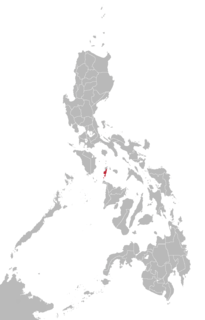
Onhan is a regional Western Bisayan language spoken, along with the Romblomanon and Asi languages, in the province of Romblon, Philippines. The language is also known as Inunhan and Loocnon.
The Buhid language is a language spoken by Mangyans in the island of Mindoro, Philippines. It is divided into eastern and western dialects.
The Tadyawan language is a language spoken by Mangyans in the southern Lake Naujan in Oriental Mindoro, Philippines.
Hanunoo, or Hanunó'o, is a language spoken by Mangyans in the island of Mindoro, Philippines.
The Alangan language is a language spoken by Mangyans in the province of Mindoro in the Philippines.
The Iraya language is a language spoken by Mangyans on the island of Mindoro in the Philippines. Zorc (1974) places the Iraya language within the North Mangyan group of Malayo-Polynesian languages, though Lobel (2013) notes that it shows "considerable differences" to Tadyawan and Alangan, the other languages in this group. There are 6,000 to 8,000 Iraya speakers, and that number is growing. The language status of Iraya is developing, meaning that this language is being put to use in a strong and healthy manner by its speakers, and it also has its own writing system.
The Southern Mindoro languages are one of two small clusters of Austronesian languages spoken by the Mangyan people of Mindoro Island in the Philippines. They make up a branch of the Greater Central Philippine subgroup.
The Northern Mindoro languages are one of two small clusters of languages spoken by the Mangyan people of Mindoro Island in the Philippines.
The Greater Central Philippine languages are a proposed subgroup of the Austronesian language family, defined by the change of Proto-Malayo-Polynesian *R to *g. They are spoken in the central and southern parts of the Philippines, and in northern Sulawesi, Indonesia. This subgroup was first proposed by Robert Blust (1991) based on lexical and phonological evidence, and is accepted by most specialists in the field.
Davaoeño (Dabawenyo) is a language of the Davao Region of Mindanao in the Philippines. According to Zorc (1977), it is a native Mansakan language influenced by Cebuano and Tagalog. Traditionally, it was the principal language of the Davaoeño people, but it is no longer spoken in Davao City as speakers have shifted to a local dialect of the Cebuano language, called Davaoeño Cebuano.
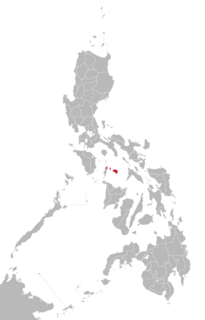
Romblomanon or Bisaya/Binisaya nga Romblomanon is an Austronesian regional language spoken, along with Asi and Onhan, in the province of Romblon in the Philippines. The language is also called Ini, Tiyad Ini, Basi, Niromblon, and Sibuyanon. It is a part of the Bisayan language family and is closely related to other Philippine languages.
References
- Barbian, Karl-Josef (1977a). English-Mangyan Vocabulary. Cebu City: University of San Carlos.
- Barbian, Karl-Josef (1977b). The Mangyan Languages of Mindoro. Cebu City: University of San Carlos.
- Zorc, David Paul (1977). The Bisayan Dialects of the Philippines: Subgrouping and Reconstruction . Canberra, Australia: Dept. of Linguistics, Research School of Pacific Studies, Australian National University. doi: 10.15144/PL-C44 . ISBN 0858831570.